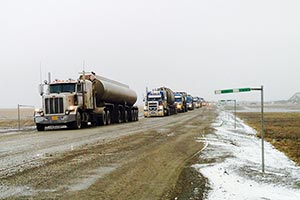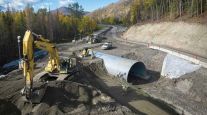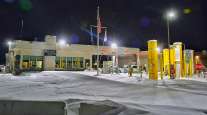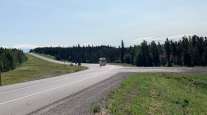Regulators: Tanker-Truck Crashes and Spills an Increasing Worry on Alaska Highways

Federal and state regulators in Alaska say they're working to stem what has been a growing number of tanker-truck accidents in recent years — including three big rollovers since September that dumped thousands of gallons of diesel fuel into woods and wetlands.
Residents in towns along the Richardson Highway where those and many other spills have occurred say they worry an out-of-control fuel tank will slam into traffic or damage fish habitat with a spill, including the salmon-rich Copper River with its prized fisheries.
Observers blame the wrecks on factors such as warming winters that increasingly glaze roads with ice, plus less highway maintenance amid Alaska's fiscal crisis and human errors by truck drivers and other motorists.
But double-tanker-truck traffic is also up since 2009, when state regulators required that ultra-low sulfur diesel be trucked to the North Slope oil fields to be used there, in line with federal regulations implemented in 2006 elsewhere in the U.S. The rules required use of the new fuel to replace diesel fuel with air-polluting high sulfur oxide emissions.
In 2005, major North Slope oil producers BP and ConocoPhillips signed an agreement with the state to manufacture the newly required diesel from crude oil on the North Slope starting in 2008, in exchange for the state supporting delayed implementation of the federal requirement, according to the Alaska Department of Environmental Conservation.
But in 2007, ConocoPhillips told reporters it would not manufacture the fuel on the Slope — a move requiring a costly upgrade of a small refinery there — after the state passed an oil-production tax under then-Gov. Sarah Palin.
Ultra-low-sulfur diesel has been produced in Alaska at two refineries, one in Valdez and the other in Kenai.
Many of the rollovers have occurred on the Richardson Highway in part because fuel headed north from the Petro Star refinery in Valdez travels by that road, officials said. Ultra-low-sulfur diesel shipped north from the Tesoro refinery in Nikiski can travel to Fairbanks by pipeline and railroad, reducing the need for fuel-truck hauls up the Seward and Parks highways.
There have been crashes with fuel spills on the Dalton Highway as well, the remote 400-mile "haul road" that is the last stretch to the Prudhoe Bay oil fields, the destination of many full tanker trucks.
Truck accidents with spills on the Dalton jumped to 15 from July 1, 2008, to June 30, 2009 — the state's 2009 fiscal year — from zero the year before, ADEC figures show. An average of eight such spills occurred annually after that on the Dalton, with thousands of gallons of fuel dumped.
But the Dalton spills fell from 13 in fiscal year 2015 to two last year as regulators worked with trucking companies to address the problem, including at a workshop in 2015 underscoring the dangers and best practices, according to ADEC.
The fuel-tanker trucks are operated by hauling companies that acquire the fuel from the refiner. They include Big State Logistics, Nana Oilfield Services, Colville and Alaska Petroleum Distributing. Those companies and others have had accidents leading to spills in recent years.
Willard Hand, a tribal environmental officer with the village of Tazlina south of Glennallen, said he drives toward the shoulder when he sees the double-tanker trucks approaching. They typically haul 8,000 gallons in a main tank and another 5,000 gallons towed with a second "pup trailer."
"I know it's not stopping easily in an emergency," Hand said.
He said the Alaska Department of Transportation and Public Facilities responded to fears in Tazlina earlier this month, agreeing to lower the highway speed limit through the community of 300 from 65 mph to 55 mph.
"Road safety concerns everyone in the community," Hand said.
Matt Carr, a longtime spill responder with the Environmental Protection Agency in Alaska, said the accidents pose a huge risk to the environment and other drivers. But they represent far less than 1% of tanker-truck traffic.
"Given the roads the truckers have to use and the conditions they transport (fuel) in, it's a testament to their skills and abilities that there have not been more," Carr said.
The crashes typically occur in winter when daylight wanes and roads are slickest. Reports of injuries, including to truck drivers, are unusual. Regulators said only some of the accidents and spills receive public attention, like three recent crashes by Big State Logistics of Fairbanks.
Aves Thompson, executive director of the Alaska Trucking Association, said trucking companies are taking other measures, including providing multiple training runs for new drivers to familiarize them with Alaska roads before they get behind the wheel.
"They want their drivers home safely at night and they don't want to damage the environment," he said.
Several factors contribute to the accidents, including drivers who aren't attentive enough and periods of thawing and freezing in recent winters that have kept roads slick.
Reduced road maintenance is also an issue, Thompson said.
The Alaska Department of Transportation has reduced its budget by $60 million over two years, a 22 percent drop. That led to the elimination of 14 maintenance positions on the Richardson and Dalton, about a 15 percent drop.
"DOT does the best they can, but they are short on funds," Thompson said.
Meadow Bailey, a DOT spokeswoman, said the agency's reductions in road work are relatively small on high-priority roads, including the Richardson and Dalton. With so many factors contributing to the tanker-truck accidents, it is incorrect to blame the accidents on the staff reductions, she said. But she added there's no staff on roads at night in some locations and responses to big storms are slower.
"We just don't have as many operators available to service roads," she said.
Distributed by Tribune Content Agency, LLC




